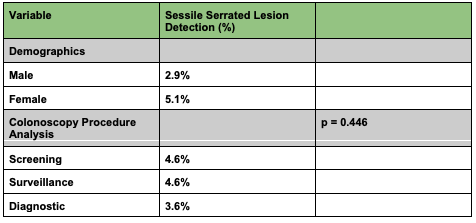Tuesday Poster Session
Category: Colon
P4543 - Advancing Recognition and Management of Sessile Serrated Lesions: Implications for Colorectal Cancer Prevention

Suria Devarapalli, DO
University of Arkansas for Medical Sciences
Little Rock, AR
Presenting Author(s)
1University of Arkansas for Medical Sciences, Little Rock, AR; 2University of Arkansas, Little Rock, AR
Introduction:
Serrated polyps are important precursors to colorectal cancer but are often studied less extensively than conventional adenomatous polyps. Currently, the national detection rate of sessile serrated lesions (SSLs) is 6.1% and is not considered an essential part for colorectal cancer screening. Sessile serrated polyps are difficult to detect due to having a flat appearance and potential presence of overlying, adherent mucus. Typically, they have an inclination for the right colon. Unlike hyperplastic polyps, sessile serrated polyps can develop dysplasia and are considered precursor lesions to colorectal carcinoma. Our study aimed to review our SSL detection rate and how to improve further.
Methods:
This was a single-center, retrospective case-control study involving patients who underwent colonoscopies between March 2024 and August 2024. Initially, we analyzed procedures performed by both gastroenterologists and surgeons; however, for a more refined analysis, we focused exclusively on colonoscopies performed by gastroenterologists. Demographic data, colonoscopy preparation data, colonoscopy procedure and pathology reports were collected and analyzed.
Results:
We had a total of 1168 patients, including screening, surveillance, and diagnostic colonoscopies. Our sessile serrated lesion detection rate was found to be 4.2% total. A logistics regression analysis was conducted to assess the relationship between age, indication for colonoscopy, and presence of SSLs. The results showed that neither age (p = 0.499) nor indication for colonoscopy (p = 0.446) significantly contributed to predicting SSL detection.
Discussion:
Recognizing serrated polyps presents an opportunity to reduce the incidence of colorectal carcinoma further. While our study found a lower-than-average national SSL detection rate, the data suggest that age and colonoscopy indication alone are not sufficient predictors. This highlights the need for further investigation into additional risk factors influencing SSL detection.
Figure: Breakdown of Sessiler Serrated Lesions (%)
Disclosures:
Suria Devarapalli indicated no relevant financial relationships.
Mauricio Garcia indicated no relevant financial relationships.
Meer Ali indicated no relevant financial relationships.
Sarin Khurana indicated no relevant financial relationships.
Suria Devarapalli, DO1, Mauricio Garcia, MD1, Meer A. Ali, MD1, Sarin Khurana, BA2. P4543 - Advancing Recognition and Management of Sessile Serrated Lesions: Implications for Colorectal Cancer Prevention, ACG 2025 Annual Scientific Meeting Abstracts. Phoenix, AZ: American College of Gastroenterology.
